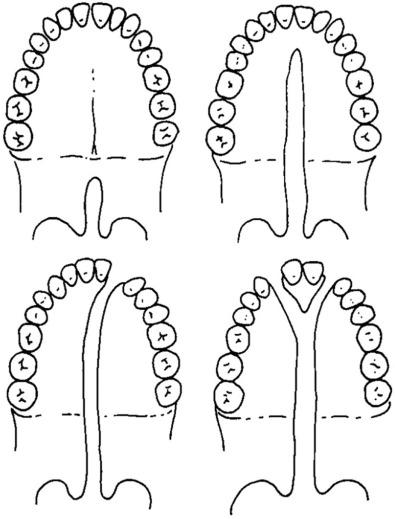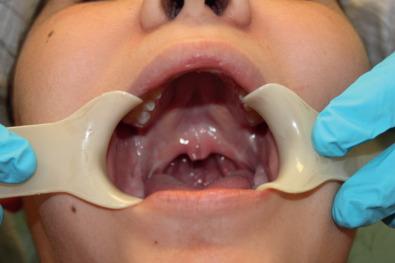Physical Address
304 North Cardinal St.
Dorchester Center, MA 02124
A cleft palate represents a developmental failure in separating the oral and the nasal cavities. The communication allows for uncontrolled passage of air, liquid, and food between the two cavities, thus significantly impairing feeding and normal speech development. Anatomically, the levator veli palatine (LVP) muscular sling is disrupted, which is characterized by an aberrant orientation and insertion of the LVP onto the posterior edge of the hard palate, with additional abnormal attachments to the aponeurosis of the tensor veli palatini, and the superior constrictor laterally. Pre-operative genetic screening and evaluation for feeding and airway should be performed and optimized. The goals of palatoplasty are to restore separation of the oral and nasal cavity and to restore the proper anatomical orientation and configuration of the levator muscle, allowing for normal function of the velopharyngeal (VP) port. The Furlow double opposing Z-plasty is the author's preferred method of palatoplasty and allows proper reorientation of the LVP, lengthening of the palate, and narrowing of the VP port in a single operation. This procedure can be safely performed throughout the world, including in developing countries. Significant post-operative complications include airway compromise, oronasal fistulas (ONFs), and persistent VP insufficiency. The risks of these complications can be significantly reduced intraoperatively with placement of a nasopharyngeal airway, careful and complete dissection of the levator muscle, and preservation of palatal blood supply.
Cleft palates are one of the most frequent congenital anomalies, and palate repair carries significant implications for speech, feeding, and airway. Anatomically, a cleft palate is a defect between the oral and nasal cavities, resulting in velopharyngeal incompetence (VPI). Feeding is compromised because negative pressure in the oral cavity cannot be maintained, and feeds are often regurgitated through the nostrils. The disrupted soft palate (velum) precludes separating the oropharynx and the nasopharynx, leading to poorly intelligible speech or VPI. Speech is the outcome measure in palatoplasty.
Overall, the etiology of cleft palates is a combination of genetic and environmental factors, such as maternal smoking, alcohol, corticosteroids, anticonvulsants, high altitude, and advanced parental age. Embryologically, the palate can be divided into the primary and secondary palate. Primary palate refers to the lip, nasal sill, alveolus, and hard palate anterior to the incisive foramen, whereas the secondary palate refers to the hard palate posterior to the incisive foramen and soft palate. The medial and lateral nasal prominences fuse with the maxillary prominences at 4 to 7 weeks of gestation to form the primary palate. The lateral palatal processes of the maxillary prominence rotate and fuse at 8 weeks of gestation to form the secondary palate. Disruption of the migration, rotation, or fusion of these processes results in a cleft palate.
Oral clefts can occur as cleft lip with or without cleft palate (CL/P) or as cleft palate in isolation (CPO). CL/P and CPO are pathogenetically and epidemiologically distinct anomalies. Failure of mesodermal penetration is thought to result in CL/P, whereas CPO occurs from failure of epithelial fusion. CPO has an equal racial distribution, 2 : 1 female/male distribution, and overall incidence of 0.5 : 1000 births. Conversely, CL/P has predilection for Asians (Asian 2 : 1000, White 1 : 1000, Black 0.5/1000) and a 1 : 2 female/male distribution. Both CL/P and CPO can be associated with other congenital anomalies, which can be considered non-syndromic or syndromic. Non-syndromic cleft palates represent an anomaly resulting from a single initiating event or malformation, whereas syndromic clefts involve multiple malformations in multiple developmental fields, frequently occurring together. Pierre Robin sequence (PRS) is a commonly associated anomaly in non-syndromic cleft palate. The triad of micrognathia, glossoptosis, and airway obstruction is a core finding; however, cleft palate is commonly seen but not necessary for diagnosis. In comparison, there are over 300 syndromes that are associated with a cleft palate, of which Stickler syndrome, velocardiofacial syndrome, and Van der Woude syndrome are the most common. Hence patients with a cleft palate should have a genetic screening and consultation.
Currently, there are several classification systems (diagrammatic vs symbolic) used to describe oral clefts. The Veau Classification, described in 1931, is diagrammatic and still frequently used when describing cleft palates ( Fig. 3.4.1 ). There are four groups in the classification: (1) clefts isolated to soft palate, (2) clefts of soft palate and hard palate posterior to the incisive foramen, (3) complete unilateral palatal clefts, usually associated with cleft lip and palate, and (4) complete bilateral palatal clefts, usually associated with cleft lip and palate. Submucous cleft palates are not included in the Veau Classification, but represent clefts of the velar musculature with intact mucosa ( Fig. 3.4.2 ).


The goals of primary palatoplasty are (1) complete separation of the oral and nasal cavity, (2) restoration of the anatomy of the velar musculature, and (3) normal speech or VP competence. Feeding is significantly improved with oral-nasal separation, which prevents nasal regurgitation of food/liquid and allows adequate negative pressure to be generated in the oral cavity. Achieving VP competence requires both anatomical and functional correction of the velar anatomy. Restoring velar anatomy can also improve eustachian tube function, which reduces recurrent otitis media and supports improvement in hearing.
Become a Clinical Tree membership for Full access and enjoy Unlimited articles
If you are a member. Log in here